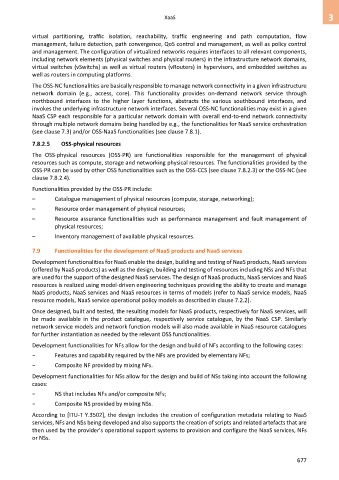Page 685 - Cloud computing: From paradigm to operation
P. 685
XaaS 3
virtual partitioning, traffic isolation, reachability, traffic engineering and path computation, flow
management, failure detection, path convergence, QoS control and management, as well as policy control
and management. The configuration of virtualized networks requires interfaces to all relevant components,
including network elements (physical switches and physical routers) in the infrastructure network domains,
virtual switches (vSwitchs) as well as virtual routers (vRouters) in hypervisors, and embedded switches as
well as routers in computing platforms.
The OSS-NC functionalities are basically responsible to manage network connectivity in a given infrastructure
network domain (e.g., access, core). This functionality provides on-demand network service through
northbound interfaces to the higher layer functions, abstracts the various southbound interfaces, and
invokes the underlying infrastructure network interfaces. Several OSS-NC functionalities may exist in a given
NaaS CSP each responsible for a particular network domain with overall end-to-end network connectivity
through multiple network domains being handled by e.g., the functionalities for NaaS service orchestration
(see clause 7.3) and/or OSS-NaaS functionalities (see clause 7.8.1).
7.8.2.5 OSS-physical resources
The OSS-physical resources (OSS-PR) are functionalities responsible for the management of physical
resources such as compute, storage and networking physical resources. The functionalities provided by the
OSS-PR can be used by other OSS functionalities such as the OSS-CCS (see clause 7.8.2.3) or the OSS-NC (see
clause 7.8.2.4).
Functionalities provided by the OSS-PR include:
– Catalogue management of physical resources (compute, storage, networking);
– Resource order management of physical resources;
– Resource assurance functionalities such as performance management and fault management of
physical resources;
– Inventory management of available physical resources.
7.9 Functionalities for the development of NaaS products and NaaS services
Development functionalities for NaaS enable the design, building and testing of NaaS products, NaaS services
(offered by NaaS products) as well as the design, building and testing of resources including NSs and NFs that
are used for the support of the designed NaaS services. The design of NaaS products, NaaS services and NaaS
resources is realized using model-driven engineering techniques providing the ability to create and manage
NaaS products, NaaS services and NaaS resources in terms of models (refer to NaaS service models, NaaS
resource models, NaaS service operational policy models as described in clause 7.2.2).
Once designed, built and tested, the resulting models for NaaS products, respectively for NaaS services, will
be made available in the product catalogue, respectively service catalogue, by the NaaS CSP. Similarly
network service models and network function models will also made available in NaaS resource catalogues
for further instantiation as needed by the relevant OSS functionalities.
Development functionalities for NFs allow for the design and build of NFs according to the following cases:
− Features and capability required by the NFs are provided by elementary NFs;
− Composite NF provided by mixing NFs.
Development functionalities for NSs allow for the design and build of NSs taking into account the following
cases:
− NS that includes NFs and/or composite NFs;
− Composite NS provided by mixing NSs.
According to [ITU-T Y.3502], the design includes the creation of configuration metadata relating to NaaS
services, NFs and NSs being developed and also supports the creation of scripts and related artefacts that are
then used by the provider's operational support systems to provision and configure the NaaS services, NFs
or NSs.
677

